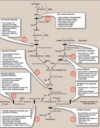Biochemistry - Pulmonary / Renal Block (I) Flashcards
(198 cards)
Describe the hypothesized signalling mechanism by which proteins that are being synthesized end up in the rough endoplasmic reticulum.
(1) Translation begins in the cytosol; an RER-targeting sequence on the partially synthesized protein is bound by a signal recognition particle (SRP).
(2) Upon binding to an SRP receptor in the RER, GTP hydrolysis opens an associated translocon protein (the RER channel opens, and the SRP dissociates from the ribosome).
(3) Translation continues directly through the translocon and into the RER lumen; signal peptidase cleaves the signalling sequence on the synthesized protein.

Secretory proteins begin their translation in the ________, where an N’ signalling sequence targets them towards the RER.
Upon entering the RER, what cleaves this signalling sequence from the newly synthesized proteins?
Cytosol;
signal peptidase (in the RER membrane)

What are the two main purposes of protein glycosylation?
What are some other purposes?
Folding, targeting;
E-leaflet protein stability, enhanced cell-to-cell contact
________ are carbohydrate-binding proteins, and can interact with other glycosylated proteins.
Lectins
Lectins are ___________-binding proteins, and can interact with other ___________ proteins.
Carbohydrate;
glycosylated
True/False.
Glycosylation is typically the addition of single glucose monomers to amino acid side chains.
False;
it is usually the addition of glycans (either single oligosaccharides or complexes) to amino acid side chains.
What are the two types of protein glycosylation?
O-linked;
N-linked
N-linked glycosylation occurs in the _____________.
O-linked glycosylation occurs in the _____________.
RER;
Golgi apparatus
Describe O-linked glycosylation (in terms of starting substrate and any involved amino acids or enzymes).
Give an example.
Individual carbohydrates are sequentially added to –OH groups of serine or threonine by glycosyl transferases;
the formation of ABO blood antigens
Describe N-linked glycosylation (in terms of starting substrate and any involved amino acids or enzymes).
What amino acid sequence is required?
Preformed oligosaccharide complexes are added to asparagine residues as the peptide is translocated through the RER membrane (translocation process shown in attached image);

Asn - X - (Ser/Thr)
__-linked glycosylation is characterized by the addition of preformed oligosaccharide complexes to __________ residues.
__-linked glycosylation is characterized by the sequential addition of individual carbohydrates to ___________ residues.
N, Asparagine (Asn-X(Ser/Thr);
O, Serine/Threonine
Describe the steps of synthesis of the oligosaccharide complex used in N-linked glycosylation.
(1) UDP-linked sugars are added to dolichol phosphate from the cytosolic side.
(2) This complex then ‘flips’ from the cyotosolic to the RER lumen side.
(3) The completed oligosaccharide complex can then be cleaved and added to asparagine residues by oligosaccharyl transferase.

In synthesis of the oligosaccharide complexes used in N-linked glycosylation, _______-linked sugars are first added to _____________ _____________ on the cytosolic side of the RER membrane.
UDP;

dolichol phosphate
What must occur for the oligosaccharide complexes used in N-linked glycosylation to enter the RER lumen?
It ‘flips’ from the cytosolic side to the RER lumen

What is the first substrate for synthesis of the oligosaccharide complexes involved in N-linked glycosylation?
It is attached to what substance in the RER membrane?
What substance can be used in the lab to inhibit this process, thus disrupting proper protein folding?
UDP-GluNAc;
dolichol phosphate;
tunicamycin

N-linked glycosylation is accomplished via what enzyme?
Oligosaccharyl transferase

True/False.
Disulfide bonds form in many proteins synthesized both in the cytosol and the RER.
False.
Disulfide bonds form mainly in secretory proteins and proteins of the E-leaflet;
they are only made in RER-synthesized proteins
Why do disulfide bonds only form in the RER lumen?
Via what enzyme?
It is an oxidative environment;
protein disulfide isomerase
What is the most common genetic cause of liver disease (jaundice, cirrhosis) in children?
What is the most common disorder necessitating pediatric liver transplants?
α-1 antitrypsin deficiency;
α-1 antitrypsin deficiency
What percentage of emphysema cases are due to an α-1 antitrypsin deficiency?
1 - 3%
What enzyme(s) are inhibited by α-1 antitrypsin?
From what organ(s) is this protein secreted?
Elastase, trypsin;
the liver
What is the main molecular cause of an α-1 antitrypsin deficiency?
What tissues does this damage?
A point mutation inhibiting proper folding of the α-1 antitrypsin protein in the RER;
pulmonary (increased elastase activity),
hepatic (α-1 antitrypsin crystalline aggregate buildups)
GI (increased trypsin activity)
What cell type(s) secrete elastase?
Neutrophils
How does an α-1 antitrypsin deficiency damage the lungs?
How does an α-1 antitrypsin deficiency damage the GI tract?
How does an α-1 antitrypsin deficiency damage the liver?
Decreased elastase inhibition;
decreased trypsin inhibition;
misfolded α-1 antitrypsin aggregates































































